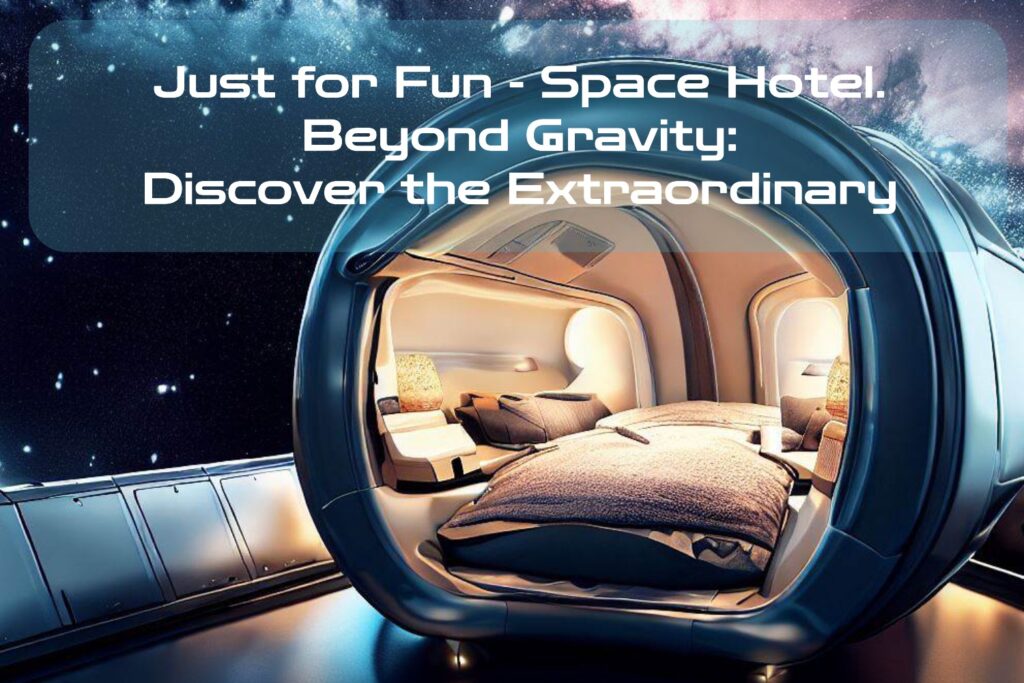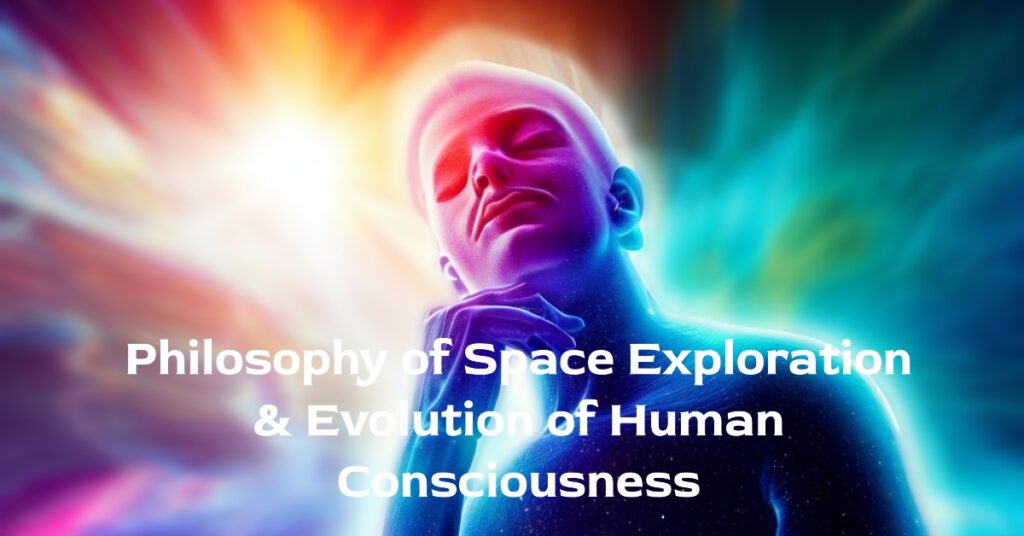The First Ever Space Hotel, a marvel of human ingenuity and ambition, marks a significant leap in the quest to make space not just explorable, but also inhabitable and enjoyable. This pioneering project, spearheaded by leading space exploration and hospitality companies, aims to offer an unprecedented experience that blends luxury, adventure, and the sheer awe of being in space. As the appointed interior designer for this trailblazing venture, the challenge is not just to create an environment that is functional and safe in zero gravity, but also to evoke a sense of wonder, tranquility, and home for the guests amidst the vast cosmic expanse.
Conceptualization and Design Principles
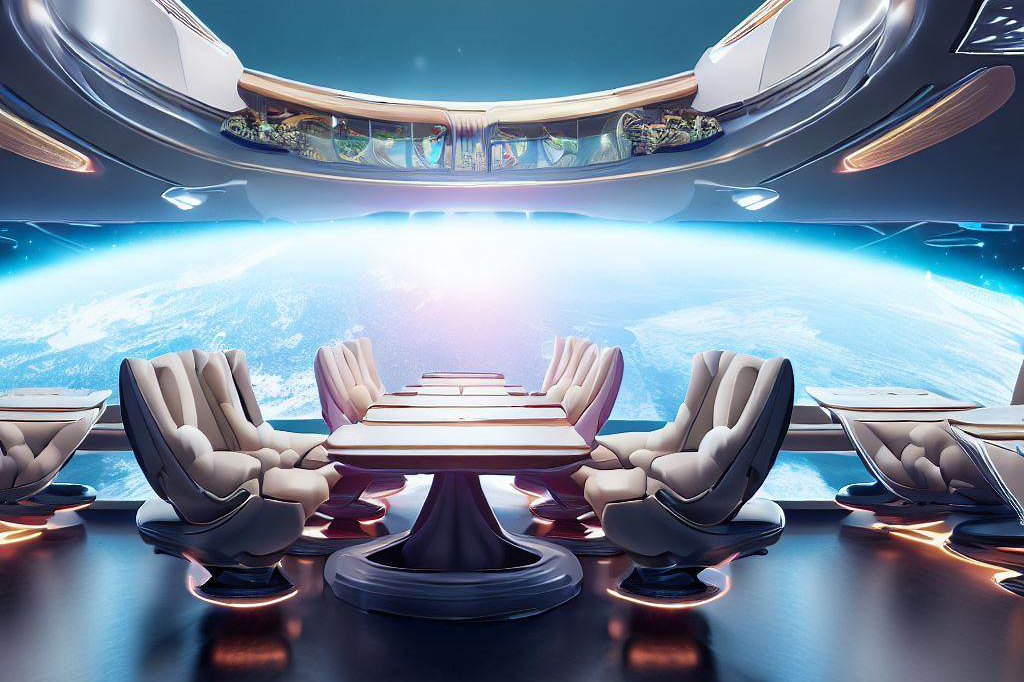
The design approach for this project is fundamentally different from any terrestrial project. Space, with its zero-gravity environment, presents a unique set of challenges that require a radical reimagining of design principles. The absence of a clear ‘up’ and ‘down’ means that every surface – whether it’s what we would normally call a floor, wall, or ceiling – could be a potential area for activity or decoration.
This not only multiplies the usable space but also necessitates special considerations to prevent disorientation and to ensure easy navigation. The design must incorporate methods for guests to anchor themselves or their belongings, and to move around with ease.
Furthermore, the hotel’s interiors must also be designed to withstand the rigors of space travel, including radiation, extreme temperatures, and the absence of an atmosphere.
However, these challenges also present an opportunity to create a truly out-of-this-world experience. The interior design will leverage the novelty of the zero-gravity environment, incorporating elements of play, surprise, and exploration, while also creating a comforting sense of familiarity and security. Aesthetic cues will be drawn from both the celestial environment outside and the rich diversity of Earth’s own natural and cultural landscapes, creating a space that is at once alien and reassuringly terrestrial.
Room Design and Furnishings
Description of the Sleeping Quarters
The design of the sleeping quarters in the First Ever Space Hotel is a blend of innovation, functionality, and comfort, creating a restful sanctuary amidst the infinite expanse of space.
1. Unique Challenges and Solutions for Sleeping in Zero Gravity
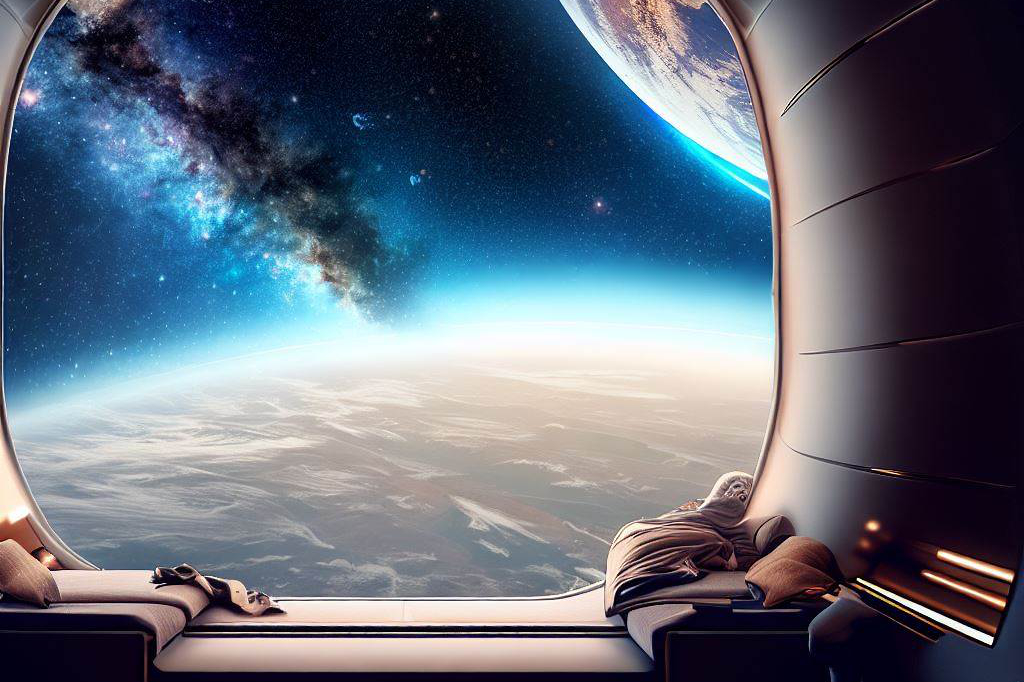
Sleeping in zero gravity presents a set of unique challenges. Traditional beds and mattresses are unsuitable due to the lack of gravity. Sleepers might float around their quarters, leading to possible collisions and an overall uncomfortable experience. To address this, the sleeping quarters are equipped with specially designed sleeping pods.
These sleeping pods are somewhat like a hybrid between a bed and a sleeping bag, with soft interior linings and secure fastenings to keep guests comfortably in place. They are designed to mimic the natural curvature of the human body, providing support where it’s most needed and allowing a comfortable and restful sleep.
The sleeping pods are also equipped with adjustable temperature control and gentle internal lighting, allowing guests to create their preferred sleep environment. The walls of the sleeping pods are built with sound-absorbing materials to minimize noise and ensure a peaceful sleep.
2. Innovative Features for Personal Storage and Privacy
In zero gravity, items can float away if not properly secured. This is a significant challenge when it comes to personal storage in the sleeping quarters. To address this, the rooms are fitted with ‘zero-g drawers and closets’. These storage units are designed with secure locking mechanisms and compartments that keep personal belongings safely in place, even in zero gravity.
For privacy, each sleeping pod is housed within its own partitioned area, with sliding doors that can be closed or left open as per the guest’s preference. The doors and walls are constructed with smart glass that can transition from transparent to opaque, offering guests an unobstructed view of the cosmos, or complete privacy at the touch of a button.
Furthermore, each sleeping quarter is equipped with a state-of-the-art infotainment system. This system is voice-activated and can display news, entertainment, or even simulate views of Earth on the smart glass surfaces, helping guests stay connected with home while they are millions of miles away.
Description of the Communal Areas
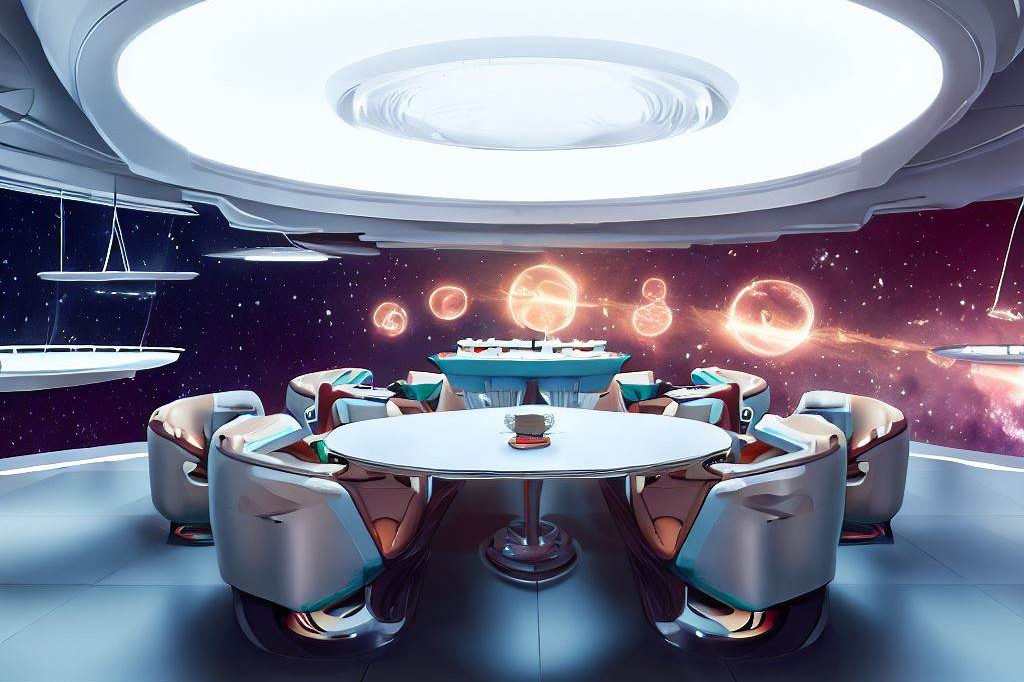
The communal areas of the First Ever Space Hotel are designed to foster a sense of community among guests, promoting shared experiences and camaraderie in the face of the vast and awe-inspiring cosmos. The hotel features various communal spaces, including a dining area for communal meals and an observation deck for leisure and relaxation.
1. How Seating and Tables are Designed for Zero Gravity
Designing seating and tables for a zero-gravity environment is a challenge that necessitates a complete reimagining of traditional furniture. In the dining area, instead of conventional tables and chairs, we’ve designed a circular setup with individual ‘dining pods’. These pods, lined along the edges of the circular structure, have body-contoured seats with gentle restraints to keep guests comfortably in place while they dine.
The dining pods are positioned facing the center of the circle, where a ‘floating’ communal table resides. This table is designed with multiple magnetic surfaces where dishes and utensils can be securely placed, preventing them from floating away. Food and drinks are served in specially designed containers that use surface tension to keep the food in place and allow guests to eat with specially crafted magnetic cutlery.
The observation deck, on the other hand, features body-contoured loungers with restraints, allowing guests to relax and enjoy the views without floating away. These loungers can swivel 360 degrees, enabling guests to view any part of the cosmos they wish.
2. Use of Viewports and Screens for Awe-inspiring Views
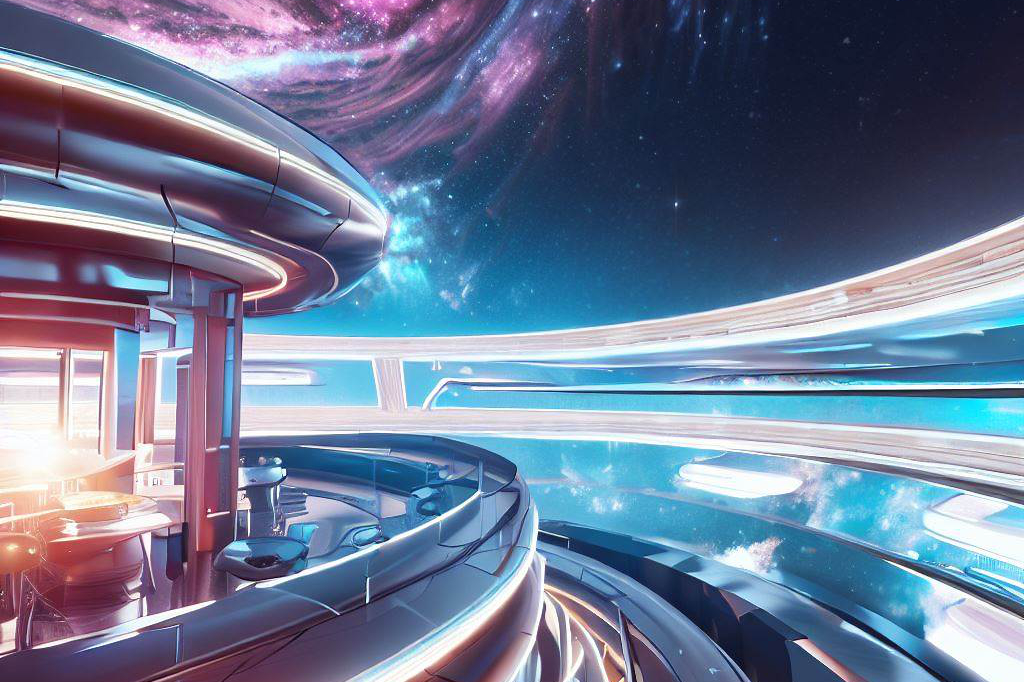
The views of outer space are one of the most attractive features of the First Ever Space Hotel, and we’ve capitalized on this by incorporating large viewports in the communal areas. These viewports are made of reinforced transparent material, allowing unobstructed views of the star-studded cosmos.
The dining area features a panoramic viewport, providing diners with an extraordinary backdrop of stars, planets, and distant galaxies while they enjoy their meals. The observation deck, meanwhile, is designed as a 360-degree viewing platform, offering guests a breathtaking, immersive experience of the cosmos.
In addition to these viewports, the communal areas also feature large, high-definition screens that can display various kinds of information, from real-time data about nearby celestial bodies to live broadcasts from Earth. These screens can also simulate different views, such as a soothing Earth sunrise, a tranquil ocean scene, or even a bustling cityscape, providing a variety of sensory experiences for guests.
Description of the Hygiene Facilities
Hygiene facilities in the First Ever Space Hotel are designed with utmost care, incorporating novel technologies to ensure guests’ comfort and well-being even in a zero-gravity environment. The facilities include bathrooms for personal hygiene and a gym for physical exercise and relaxation.
1. Novel Technologies for Maintaining Hygiene in Zero Gravity
In a zero-gravity environment, traditional showers and toilets cannot function due to the lack of gravity. As a solution, the bathrooms in the Space Hotel employ advanced technologies designed specifically for space conditions.
For bathing, we’ve introduced ‘vapor showers’. These showers use a fine mist of water and gentle suction to clean the body, eliminating the need for running water. The mist is evenly applied over the body, and dirt and excess water are then vacuumed away, leaving the body clean and dry. This system ensures that water does not float around and cause potential problems.
The toilets use a similar suction-based technology. The system carefully directs waste into a secure storage unit using airflow, which is then treated and stored for disposal upon returning to Earth. The unit is self-cleaning, using antibacterial UV light to maintain hygiene standards.
In addition, the hotel features robotic cleaning systems that periodically sanitize common touchpoints and surfaces, ensuring a clean environment.
Features for Exercise and Relaxation in the Hotel
Exercise is crucial in space to counteract the effects of prolonged weightlessness on the body. The Space Hotel’s gym is equipped with specially designed fitness equipment that allows guests to work out effectively in zero gravity.
The gym includes resistance devices that use elastic bands or pneumatic systems, treadmills with waist harnesses, and a variety of other devices that allow guests to exercise all major muscle groups. Each piece of equipment is designed with safety restraints to keep the user in place during their workout.
For relaxation, the gym also includes a ‘meditation sphere’—a tranquil, softly lit environment where guests can meditate or practice yoga with a stunning view of space. Additionally, there are virtual reality relaxation pods where guests can enjoy a range of immersive relaxation experiences, from floating in a peaceful ocean to walking through a lush forest.
These facilities ensure that guests can maintain their physical health and wellness while also enjoying a range of relaxation options, helping to make their stay in the Space Hotel a truly holistic experience.
Material and Colors

The selection of materials and colors for the First Ever Space Hotel is a crucial aspect of the design process, requiring careful consideration of both practical and aesthetic factors.
On the Selection of Materials Resistant to Space Conditions
The extreme conditions in space necessitate the use of materials that are highly durable, resistant to radiation, and able to withstand significant temperature variations. These materials also need to be lightweight to minimize the cost and environmental impact of launching them into space.
For the structural elements, we primarily use advanced aerospace-grade alloys and composites, known for their strength, durability, and resistance to radiation and extreme temperatures. Interior surfaces are coated with a specially designed material that is resistant to bacterial growth, helping to maintain hygiene in the hotel.
For the furnishings, we use high-performance synthetic fabrics that are durable, easy to clean, and resistant to UV radiation. These fabrics are also flame-retardant, providing an additional layer of safety.
The sleeping pods and seating are lined with memory foam-like material that conforms to the body, providing comfortable support in a zero-gravity environment. This material also has excellent resistance to temperature variations, ensuring it maintains its performance and comfort over time.
Use of Colors to Create a Harmonious and Calming Environment, Considering the Constant View of Space

The color palette for the Space Hotel has been carefully selected to create a harmonious and calming environment, taking into account the constant view of the deep blackness of space peppered with stars.
We use a blend of cool and warm tones to create a balanced and comforting ambiance. Shades of blue, reminiscent of Earth’s oceans and sky, are used as the dominant color to evoke a sense of tranquility and connection to our home planet. These blues are complemented with softer hues of gray, symbolizing the lunar and asteroid bodies in our solar system.
To add warmth, we’ve incorporated touches of gold, bronze, and rich browns, inspired by the sun and the planets. These warmer colors also echo the hues of spacecraft and space suits, subtly evoking the pioneering spirit of space travel.
All surfaces have a matte finish to prevent any distracting reflections from the bright lights inside the hotel or the sunlight coming through the viewports. The overall color scheme is designed to soothe the senses and create a comforting, familiar environment amidst the extraordinary setting of outer space.
Safety Features
The safety of the guests is the utmost priority in the design of the First Ever Space Hotel. The hotel incorporates numerous safety precautions and emergency features, ensuring a secure environment while maintaining a seamless and unobtrusive design.
Explanation of Safety Precautions Embedded in the Design
The lack of gravity presents unique challenges in terms of movement and stability. To address this, the design of the hotel integrates a system of handrails and straps throughout the interiors. These elements are ergonomically designed and strategically positioned to aid guests in moving around the hotel, providing support where needed.
The handrails, fashioned from the same durable materials as the structure of the hotel, are located along all corridors and major communal spaces. They are color-coded to aid in navigation and subtly illuminated for visibility in low light conditions.
In the sleeping quarters, dining area, and gym, straps are used to help guests secure themselves when necessary. In the sleeping pods, straps gently hold guests in place while they sleep. In the dining area, restraints are built into the seating to prevent guests from floating away while eating. The gym equipment also features secure restraints to ensure safe workouts.
All surfaces, including floors, walls, and ceilings, are treated with non-slip coatings to prevent guests from inadvertently pushing off with too much force and losing control.
Emergency Features and How They Are Seamlessly Integrated into the Design
Emergency preparedness is a crucial aspect of the hotel’s design. The hotel is equipped with a state-of-the-art emergency system that includes fire suppression technology, emergency life-support systems, and clear evacuation procedures.
Fire suppression in a zero-gravity environment can’t rely on traditional sprinkler systems. Instead, the hotel employs a network of sensors that can detect heat or smoke, triggering a system that replaces the ambient air with a fire-suppressant gas to quickly extinguish any potential flames.
The hotel also features emergency life-support packs that are stored at regular intervals throughout the hotel. These packs contain oxygen masks, first aid supplies, and emergency rations. They are designed to be easily identifiable and accessible, with their storage locations clearly marked and illuminated.
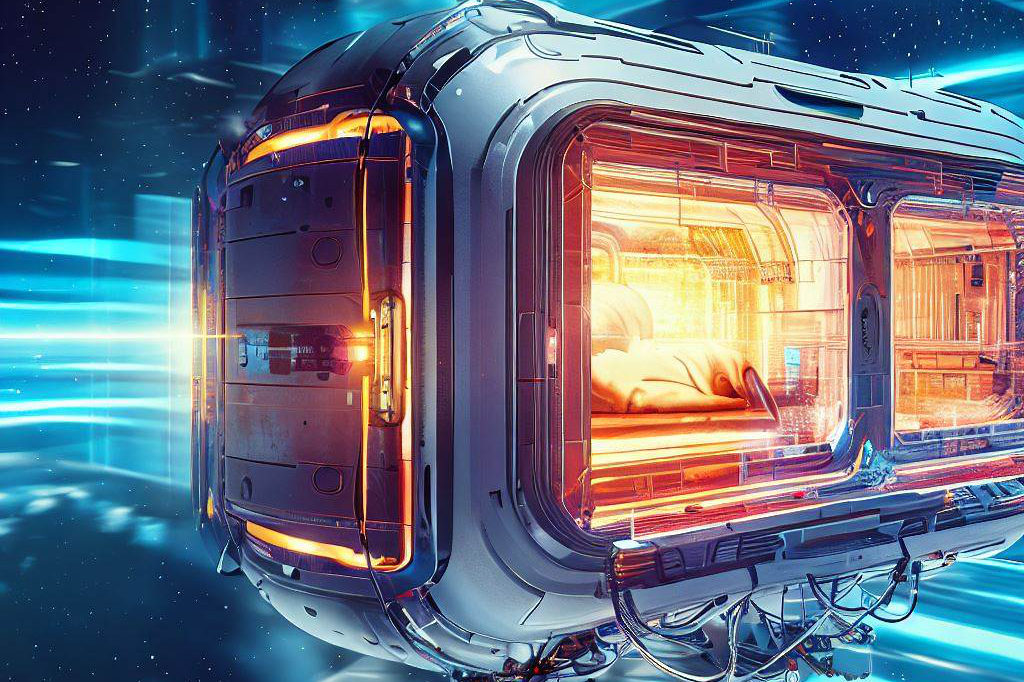
In the event of a serious emergency that requires evacuation, the hotel has a system of escape pods. These pods are designed to be easily accessible from all areas of the hotel, with clear signage guiding guests to the nearest pod. Each pod is equipped with life-support systems and can navigate autonomously to a safe location.
All these safety and emergency features are integrated into the design in a way that is unobtrusive yet easily accessible and understandable, ensuring that guests can enjoy their stay with the reassurance that they are in a safe and secure environment.
Environmental Considerations
Operating in the unique environment of space, the First Ever Space Hotel takes its responsibility towards the environment seriously. The hotel incorporates a range of features aimed at minimizing waste, recycling resources, and creating a comfortable environment for guests.
Systems for Recycling and Minimizing Waste
Recognizing the importance of resource conservation in space, the Space Hotel employs advanced recycling systems to minimize waste and maximize the reusability of resources.
Water is one of the most crucial resources in space. The hotel’s water recycling system recovers and purifies water from all possible sources, including humidity from the air and wastewater from showers and sinks. This purified water is then used for various purposes, such as providing drinking water, rehydrating food, and supplying the vapor showers.
The hotel also features a waste management system that employs a combination of compaction, dehydration, and sterilization to handle solid waste. This system not only reduces the volume of waste but also recovers resources where possible—for example, certain types of waste can be processed to extract valuable minerals.
In terms of food waste, the hotel employs a composting system that transforms organic waste into a nutrient-rich substance. This compost can then be used in the hotel’s experimental zero-gravity greenhouse, contributing to the production of fresh food in space.
Features for Controlling Lighting and Temperature to Mimic a 24-hour Day and Keep Guests Comfortable
The constant exposure to the blackness of space can be disorienting for guests. To mitigate this, the Space Hotel uses a smart lighting system to replicate the 24-hour day-night cycle of Earth.
During the ‘day’, the lighting system provides a bright, natural light that simulates sunlight, helping guests stay alert and oriented. As the ‘evening’ approaches, the lights gradually shift to warmer tones, mimicking the setting sun and helping guests wind down. Overnight, the lights dim to a soft, moonlight-like glow, although they can be adjusted as per each guest’s preference.
The hotel also features a high-tech temperature control system that maintains a comfortable ambient temperature, regardless of the extreme temperature variations in space. The system uses a network of sensors to monitor and adjust the temperature in different areas of the hotel, ensuring a consistent and comfortable environment for guests.
By minimizing waste, recycling resources, and creating a comfortable and familiar environment, the First Ever Space Hotel aims to offer a sustainable and enjoyable space tourism experience.
Reflection on the Significance of This Design Project
The design of the First Ever Space Hotel represents a monumental leap in the evolution of human habitat and technological achievement. It signifies the culmination of decades of space research and innovation, marking a new era in which space is not just a frontier for exploration, but also a domain for human experience and habitation.
This project is a testament to human ingenuity and resilience, encapsulating our capacity to adapt and thrive even in the most challenging environments. It stands as a tribute to the universal human spirit of exploration, curiosity, and the desire to push beyond our known boundaries.
Moreover, it signifies the expansion of the tourism industry into an entirely new realm, opening up unprecedented opportunities for people to experience the awe and wonder of space. It democratizes space travel, making what was once the domain of a select few astronauts accessible to a broader public.
Hopes and Predictions for the Future of Space Hotel Design
Looking ahead, we envision that the First Ever Space Hotel is just the beginning of a new era in space tourism. As more and more people venture into space, we foresee a future where space hotels become more commonplace, each offering unique experiences and amenities.
Future designs might incorporate even larger structures, possibly including features such as zero-gravity sports arenas, space spas, or even underwater-themed habitats with views of celestial bodies. We might see hotels designed to mimic different Earth environments, offering guests the chance to experience a tropical rainforest or a snowy mountain peak against the backdrop of the cosmos.
Advancements in technology will likely allow for more sustainable and efficient resource use, with improvements in recycling systems, energy generation, and perhaps even the production of food in space.
Furthermore, we anticipate future collaborations between various nations and private companies, creating a vibrant and diverse space tourism industry that not only entertains and educates but also fosters a greater sense of global unity and shared stewardship of our universe.
The design of the First Ever Space Hotel stands as a significant milestone in our journey to becoming a spacefaring civilization. As we look to the stars with hope and curiosity, we are excited to see how this endeavor will inspire new ideas, foster global cooperation, and broaden our horizons in ways we can only begin to imagine.
#JustForFun #StellarShenanigans

C M, a seasoned editor, journalist, and consultant, is deeply fascinated by the convergence of technology, space, and the future of humanity.
With a particular interest in transhumanity, futurology, and the philosophical and ethical dimensions of these domains, C M serves as the lead contributor to SpaceSpotlight and TranscendSphere.
When not penning insightful articles on these rapidly evolving fields, C M indulges in their love for podcasts and books, proudly embracing their status as a ‘Happy Nerd Extraordinaire!’
